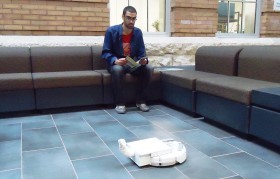« Back to Publications list
A Dog Tail for Communicating Robotic States
Download Publication File
Abstract
We present a dog-tail interface for communicating abstract affective robotic states. We believe that people have a passing knowledge to understand basic dog tail language (e.g., tail wagging means happy). This knowledge can be leveraged to understand affective states of a robot. For example, by appearing energetic, it can suggest that it has a full battery and does not need charging. To investigate this, we built a robotic tail interface to communicate affective states of a robot. We conducted an exploratory user study to explore how low-level tail parameters such as speed influence people's perceptions of affect. In this paper, we briefly describe our study design and the results obtained.
Video
Download the A Dog Tail for Communicating Robotic States video file.
Publisher Link
http://dl.acm.org.proxy1.lib.umanitoba.ca/citation.cfm?id=2447697
Citation
Ashish Singh and James E. Young. 2013. A dog tail for communicating robotic states. In adjunct proceedings (video abstracts) of the 8th ACM/IEEE international conference on Human-Robot interaction - HRI '13 (2013), 417-418. Best Video Award 2nd Prize.
Bibtext Entry
@inproceedings{Singh:2013:DTC:2447556.2447697,
author = {Singh, Ashish and Young, James E.},
title = {A dog tail for communicating robotic states},
booktitle = {Proceedings of the 8th ACM/IEEE international conference on Human-robot interaction},
series = {HRI '13},
year = {2013},
isbn = {978-1-4673-3055-8},
location = {Tokyo, Japan},
pages = {417--418},
numpages = {2},
url = {http://dl.acm.org.proxy1.lib.umanitoba.ca/citation.cfm?id=2447556.2447697},
acmid = {2447697},
publisher = {IEEE Press},
address = {Piscataway, NJ, USA},
keywords = {animal-inspired interfaces, human-robot interaction}
}




